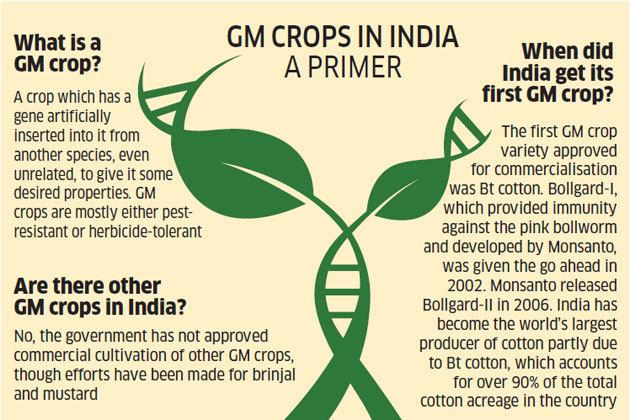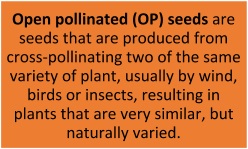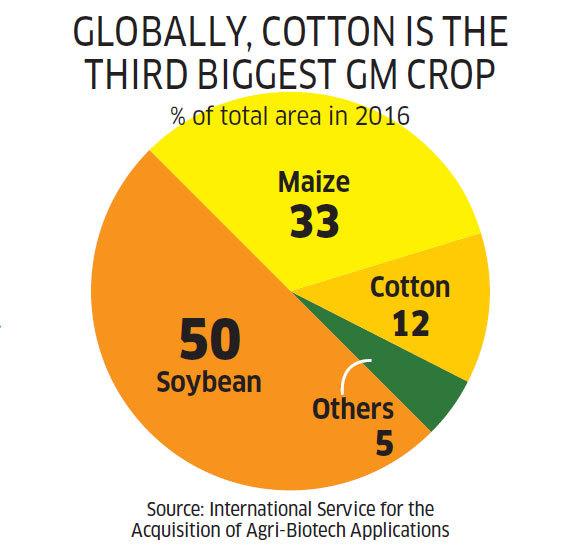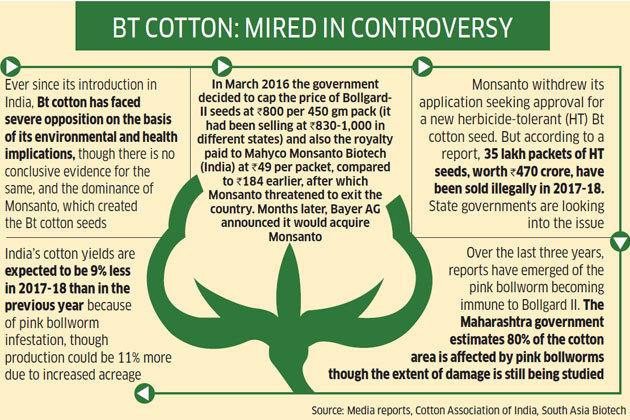(HOT) UPSC Current Affairs 2025 PDF
NEW! The Gist (NOV-2025) | E-BOOKS
A Perfect storm in the cotton field : Important Topics for UPSC Exams

A Perfect storm in the cotton field : Important Topics for UPSC Exams
Bt cotton stands for Bacillus thuringiensis cotton as the strains of the bacterium Bacillus thuringiensis present in Bt cotton produce over 200 different Bt toxins, each harmful to different insects and thus protecting the cotton crop against the attacks of insects. But despite this, India is the only Bt cotton-growing country facing the problem of pink bollworm infestation at present.

Why in News?
-
The government had cut royalties that local seed companies pay to Monsanto, for the second time in two years.
-
In February 2018, anti-trust regulator, the Competition Commission of India, decided to probe into anti-competitive practices by Monsanto. At the centre of all this is the pink bollworm infestation plaguing cotton farmers.
Status of Cotton Cultivation in India
-
When Monsanto introduced Bt cotton in India, the technology was so popular that cotton farmers shifted to it en masse and as there was no open-pollinated Bt option, they were also forced to shift en masse to hybrids.
-
From 2002 to 2011, the area under cotton hybrids rose from 2% in north India and 40% elsewhere to 96% across the country.
Buy Printed Complete Study Materials for UPSC IAS PRELIMS Exam
Online Crash Course for UPSC PRE Exam
Analysis
-
Even though Bollgard 2, or BG-2, Monsanto’s second generation insecticidal technology for cotton, was supposed to protect crops against the pink bollworm, the pest has grown resistant to the toxins produced by this trait.
-
As a result, farmers now spend more on pesticides to control infestations and this, along with the high cost of Bt seeds, is driving farmers to poverty.
A step forward or two step backward solution
-
One solution suggested by the National Seed Association of India is for the government to encourage a move back to Bollgard, the first iteration of Bt cotton, as Monsanto hasn’t patented BG in India.
-
Both BG, which has a single bacterial gene called CryA1C, and BG-2, which has CryA1C and Cry2AB2, are designed to protect against pink bollworm.
-
BG began failing against the pest in 2009, while BG-2 began failing in 2014.
-
While criticisers of this step mention even if BG-2 doesn’t fend off the pink bollworm, it still protects against other pests like the tobacco cutworm and the American bollworm and the presence of two Bt genes in BG-2 means it will be more effective than BG in delaying resistance against these pests. Thus, when the whole world is moving towards BG-3, will our movement towards BG is not appropriate.
Other serious issues
-
As all the companies may not move towards BG, so existence of BG-2 and BG simultaneously, will give way to increased pest resistance.
A unique issue with India
-
Interestingly, none of the other 14 Bt cotton-growing countries have seen this resistance.
-
China still successfully controls pink bollworm with first-generation Bt cotton and the U.S. and Australia are moving on to third-generation BG-3 without having faced this problem.
Why such issue of Pink bollworm infection with India only?
-
The pink bollworm grew resistant because India restricted itself to cultivating long-duration hybrids since the introduction of Bt cotton in 2002.

-
The long duration of Indian cotton crops, between 160 and 300 days, allows this pest to thrive and evolve resistance more quickly than it can for short-duration crops while other cotton-growing countries strictly terminate the crop within 160 days.
-
Hybrids are crosses between two crops that often see higher yields than their parents, in a genetic phenomenon called heterosis and all other Bt cotton-growing countries mainly grow open-pollinated cotton varieties rather than hybrids.
-
When Monsanto licensed its BG and BG-2 traits to Indian seed companies, the agreement restricted the introduction of these traits to hybrids only and at the same time hybrids are financially more attractive to Indian seed companies because they offer a “value capture mechanism”.
-
India is the only country whose intellectual property laws have never prevented its farmers from either saving or selling seeds while other countries restrict saving and selling of seeds in various degrees. Over 70 countries that are members of the International Union for the Protection of New Varieties of Plants, for example, allow farmers to reuse seeds from a protected plant variety, but not to sell them. In the U.S., where plant varieties are patented, the patented seeds cannot even be reused. Without such protections, several seed companies in India prefer hybrids because unlike open-pollinated varieties, hybrids lose their genetic stability when their seeds are replanted. This compels farmers to repurchase seeds each year, protecting corporate revenues.
Disadvantages of using Hybrid over Open Pollinated Bt Cotton
-
Not only are hybrids expensive, they are also bigger and bushier, forcing farmers to cultivate them at low densities — 11,000 to 16,000 crops per acre. This is suboptimal — countries like the U.S. and Brazil plant cotton at 80,000 to 100,000 per acre.
-
To make up for the low densities, Indian farmers grow them for longer periods so that they produce enough cotton.
Way Ahead-
-
Solution to the problem is to move swiftly to short-duration varieties and this is where Monsanto’s first-generation Bollgard comes in.
-
Seed companies cannot develop open-pollinated varieties with BG-2, but they can with BG, since Monsanto didn’t patent BG in India.
MODEL QUESTIONS
Q. Which of the following statement is wrong?
A. Bollgard 2, is Monsanto’s second generation insecticidal technology for cotton.
B. Open pollinated (OP) seeds are seeds that are produced from cross-pollinating two of the same variety of plant, usually by wind, birds or insects etc.
C. Both BG, which has a single bacterial gene called CryA1C, and BG-2, which has CryA1C and Cry2AB2, are designed to protect against pink bollworm.
D. None of the above.



